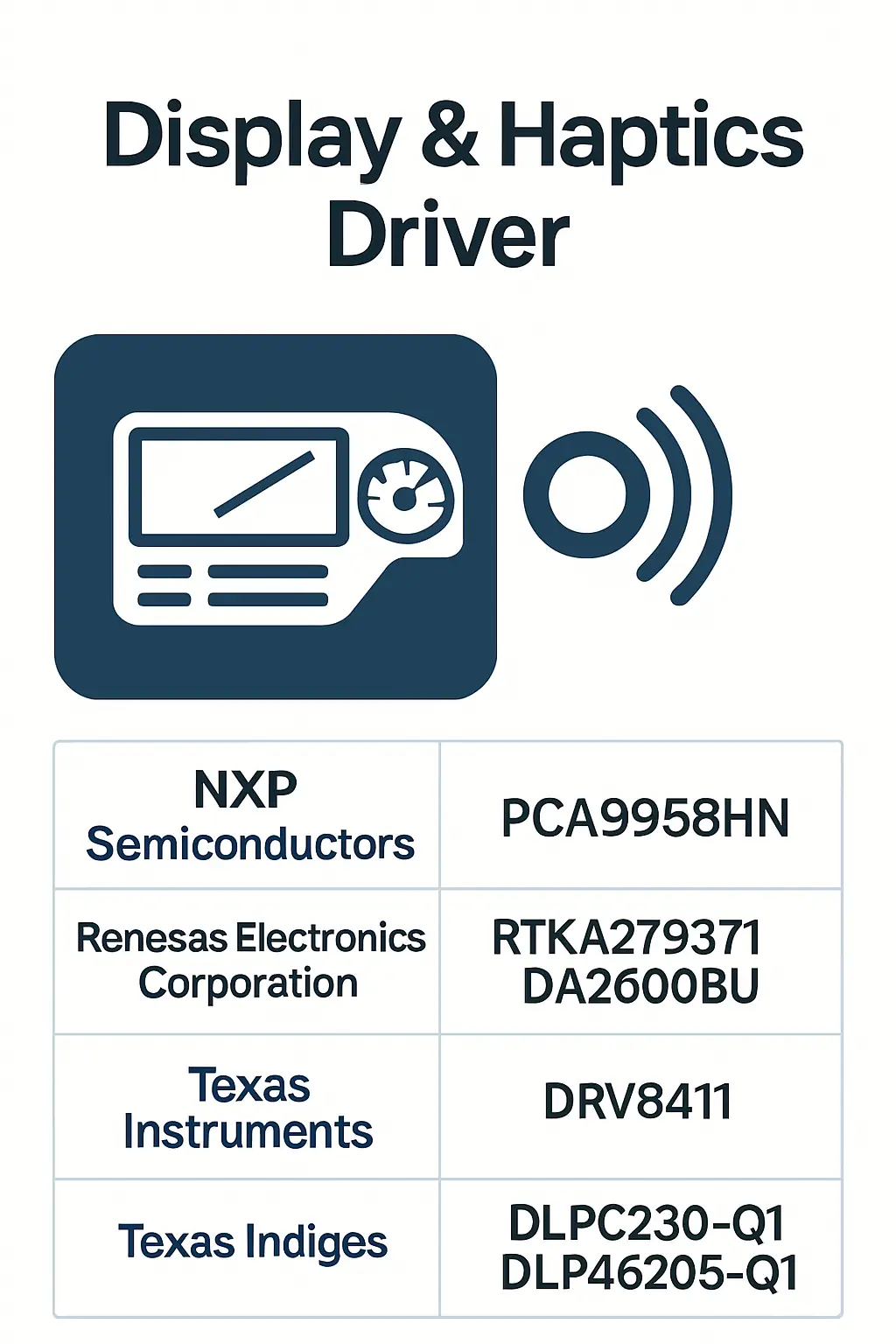Display & Haptics Driver
The Display & Haptics Driver is a critical component within the Digital Cluster & Display subsystem of an Infotainment & Digital Cockpit system in modern Automotive Electronics. It serves as the interface between the vehicle's central control unit and the display and haptic feedback systems, enabling seamless interaction between the driver and the vehicle's digital interface.
This driver is responsible for rendering high-resolution graphics on the instrument cluster and infotainment screen, ensuring clear and real-time information presentation, such as speed, navigation, and vehicle status. It also manages haptic feedback, providing tactile responses to user inputs, enhancing the driving experience with intuitive and responsive controls.
The Display & Haptics Driver is widely used in advanced driver assistance systems (ADAS), where accurate visual and tactile feedback is essential for safety and usability. It supports customizable dashboards, multi-display setups, and integration with voice and touch controls, making it suitable for luxury and high-performance vehicles.
Designed for reliability and performance, this component operates under extreme environmental conditions, ensuring consistent functionality in various driving scenarios. Its application extends to both traditional internal combustion engine vehicles and electric vehicles, supporting the evolving needs of smart mobility solutions.
In summary, the Display & Haptics Driver plays a vital role in enhancing the user experience, safety, and functionality of modern automotive digital systems, making it an essential element in the development of next-generation vehicles.
Details
Display & Haptics Driver

Related Parts
| Series Name | Description | Manufacturer Name | Attribute Description |
|---|---|---|---|
| NXP Semiconductors | 24-channel FET driver, 1.8A sink current, 12-bit PWM dimming, I²C interface, 3.3V/5V operation, 0 to 40 V output, 1 MHz clock, 2.3 mm × 3.3 mm TSSOP24 package. | ||
| NXP Semiconductors | 32-bit Power Architecture core, up to 120 MHz, 2 MB Flash, 192 KB RAM, supports automotive applications with ASIL-D safety, integrated e200z core, multiple CAN, LIN, FlexRay interfaces. | ||
| NXP Semiconductors | 32-bit Power Architecture core, up to 160 MHz, 512 KB–1 MB flash, 64 KB–128 KB RAM, CAN, LIN, Ethernet, ADC, PWM, -40°C to 125°C operating temperature, 176-pin LQFP and BGA packages. | ||
| Renesas Electronics Corporation | Real-time clock with integrated oscillator, 32.768kHz, I2C interface, operating voltage 1.8V to 5.5V, low power consumption, ±5ppm accuracy, embedded battery backup support. | ||
| Renesas Electronics Corporation | 16-bit MCU, 20 MHz, 128 KB Flash, 8 KB RAM, 48-pin LQFP, 2.7-5.5V operation, CAN, LIN, I2C, SPI, ADC, PWM, watchdog timer, operating temp -40°C to +85°C | ||
| Renesas Electronics Corporation | 1.8V to 5.5V input voltage range; 300mA output current; fixed 1.2V output; low dropout voltage; 25μA quiescent current; thermal shutdown protection; small 6-lead SC70 package. | ||
| Texas Instruments | Haptic driver with ERM/LRA support, 1.8V to 5.5V supply, I2C interface, built-in waveform library, auto-resonance tracking, 3W max power, 2.0mm × 2.0mm WQFN package. | ||
| Texas Instruments | 3.8V to 18V input, 1A output, 2.2MHz fixed frequency, synchronous step-down converter, efficiency up to 95%, over-current and thermal protection, enable pin, small 2mm × 2mm QFN package. | ||
| Texas Instruments | 3.3V, 8-bit, high-speed USB transceiver with integrated termination, 40-pin QFN package, operating temperature: -40°C to 125°C, supports USB 2.0 full-speed and low-speed modes. | ||
| Texas Instruments | 32-bit C2000™ MCU, 60 MHz, 128 KB Flash, 12-bit ADC, PWM, eCAP, eQEP, SPI, I2C, UART, temp range -40 to 125°C, automotive grade |








.png?x-oss-process=image/format,webp/resize,h_32)










